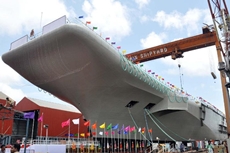China launches its first fully indigenous aircraft carrier
26 Apr 2017
China today launched its first domestically designed and built aircraft carrier as the country seeks to transform its navy into a force capable of projecting power on the high seas amid rising tensions in the South China Sea.
 The 50,000-ton carrier left its berth this morning in the northern port city of Dalian, where its predecessor, the Ukrainian-built Liaoning, also underwent extensive refurbishing before being commissioned in 2012, the Chinese ministry of national defense said.
The 50,000-ton carrier left its berth this morning in the northern port city of Dalian, where its predecessor, the Ukrainian-built Liaoning, also underwent extensive refurbishing before being commissioned in 2012, the Chinese ministry of national defense said.
The new Type 001A carrier is expected to be formally commissioned sometime before 2020 following the completion of sea trials and the arrival of its full air complement.
Like the 60,000-ton Liaoning, the new carrier is based on the former Soviet Union's Kuznetsov class design, with a ski jump-style deck for taking off and a conventional oil-fuelled steam turbine power plant. That limits the weight of payloads its planes can carry, its speed and the amount of time it can spend at sea relative to American nuclear-powered carriers. The new vessel is 315 metres long, 75 metres wide and has a cruising speed of 31 knots.
Initial news reports did not give the carrier's name. However, Chinese media speculated it may be called "Shandong" because it is docked at the Qingdao carrier base in Shandong province.
The new carrier looks similar to the Liaoning, but military experts said its layout, equipment and overall operational concept are advanced, including a bigger hangar to carry more J-15 fighter jets and more space on deck for helicopters and other aircraft.
According to Chinese media reports, the new carrier will carry 24 Shenyang J-15 fighters, based on the Russian Sukhoi Su-33, along with 12 helicopters for anti-submarine warfare, airborne early warning and rescue operations. That compares to 85-90 fixed wing aircraft and helicopters carried by a Nimitz-class carrier.
China's first aircraft carrier, the Liaoning, was bought from Ukraine in 1998. When commissioned, this will be the nation's first domestically-built carrier. China now becomes the seventh country with the capability to build its own carriers aircraft after the US, Russia, Britain, France, Italy and Spain.
The new carrier is part of an ambitious expansion of the Chinese navy, which is projected to have a total of 265-273 warships, submarines and logistics vessels by 2020, according to the Washington-based Center for Naval Analysis. That compares with 275 deployable battle force ships presently in the US Navy, China's primary rival in the Asia-Pacific. Meanwhile, China's naval expansion is also fuelling a reported push for a five-fold expansion of the marine corps to as many as 100,000 troops.
China may be planning to build at least two, and possibly as many as four, additional carriers, with one of them, the Type 002, reported to be already under construction at a shipyard outside Shanghai.
These carriers are expected to be closer in size to the US Navy's nuclear-powered 100,000-ton Nimitz class ships, with flat flight decks and catapults to allow planes to launch with more bombs and fuel aboard. The US operates 10 aircraft carriers, has 62 destroyers to China's 32, and 75 submarines to China's 68.






























